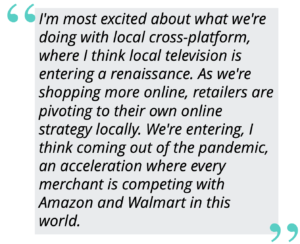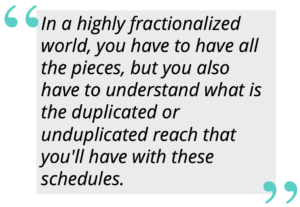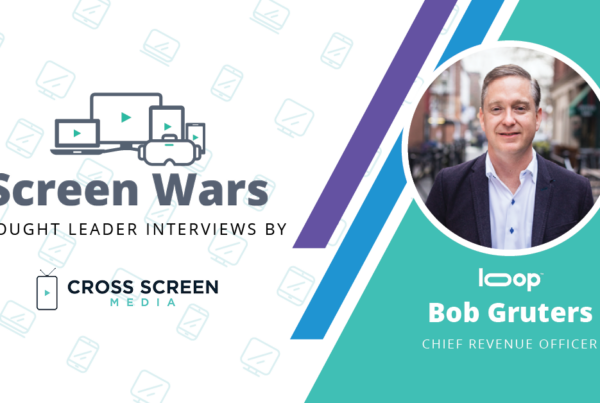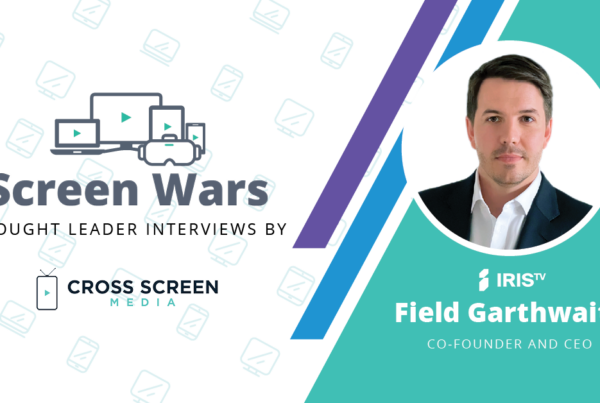Comscore CEO Bill Livek joins Cross Screen Media CEO Michael Beach to share his expertise on the opportunities and challenges across the Convergent TV Space in our latest Screen Wars Thought Leader Interview. Full transcript below.
Michael Beach: Welcome to another edition of our Screen Wars Thought Leader Interview series, where we’re talking to leaders in the Convergent TV space. Today, we are honored and very lucky to have Bill Livek, CEO from Comscore, join us. Bill, thanks for joining us today.
Bill Livek: Thank you very much, Michael.
MB: We’d like to start this off with an ice breaker that we ask everyone: what was your first job and what lessons did you take away from that that have prepared you for today?
BL: My first job was actually at nine years old delivering newspapers. I did that in Chicago and it was the best learning experience that took me through my entire life and taught me the importance of making sure that customers were completely satisfied. So when I would collect my route on Friday, in the middle of February where I pulled my gloves off and my hands would be frozen, then you would get a tip if the people had dry newspapers. Not much has changed, but everything’s obviously changed in our lives since then. It’s about making sure you have a great product and great customer service.
MB: I’m sure the Lake Michigan winters weren’t too friendly to you back then.
BL: They were not, but those of us who survived it do just fine.
MB: Absolutely. How’d you get starting in the Convergent TV space?
BL: Well, it actually started while I was in college. I took ratings classes while I was at the university and became actually very interested. Shortly after college, I joined the Arbitron company when Arbitron was measuring the radio industry. I rose through the ranks there and developed a keen interest in media measurement. For the last 40 years, I’ve been focused on building services around media that help customers target what they do. I’m proud of what we built at Comscore, helping advertisers, ad agencies, and all media companies figure out how to use all the screens that we have available to us as one heck of an ad medium.
MB: Obviously, the space has been going through a tremendous amount of change for decades. I think it’s always evolving, and Comscore’s been in the middle of that since its birth. What’s the biggest change that you’ve seen in recent years and how has Comscore adapted to that change?
BL: The change is actually all the screens converging. The difference between linear TV and streaming TV and PVOD, AVOD, whatever the pundits want to call it, it’s all merged. It’s merged through the remote controls in our houses. I don’t believe that we’re looking any longer on what’s on Netflix, what’s on Amazon, what’s on channel 610, etc., HBO, Showtime – we’re looking for programs. So when I go to my remote control, I use the voice activation to tell the remote what I want to watch, and it finds it regardless of the platform that it’s on. So, I guess what I’m seeing is the consumer’s becoming agnostic to the platform. I think we’re also becoming more sensitive to the price we pay for our entertainment more than ever before.
MB: Absolutely amazing the amount of value you get today out of a $13 Netflix subscription or a $7 Disney+ subscription. Just thinking about your recent state of the OTT report, which is pretty much a standard. I think we cover it every time you release it. Just watching that share of time and thinking about how much value the consumer’s getting from services like that versus even one or two years ago is pretty incredible.
BL: Right, but in that change, Michael, it leads to enormous opportunity. So, if you think about a world where so many consumers that are great purchasers or potential purchasers of products, if they’re spending a disproportionate amount of time on non-ad supported entertainment, the entertainment that they do spend time on that’s ad supported becomes more valuable. That’s a piece of the puzzle that Comscore has filled in, is helping folks understand a heavy Netflix, Amazon viewer, where can I reach them to inform them about a product? Where are those heavy viewers of non ad-supported watching? Conventional wisdom says it’s in live sports and news, but there’s a lot more than that. Consumers watch a lot of shows that are on traditional broadcast and traditional cable TV.
I believe that we’re entering a space now with the convergence of the screens, where if you have an ad supported platform and you’re selling a world of impressions, who are those impressions? Who are the people behind them? What type of products do they have currently on? Where are they in the purchase cycle? Meaning, how old is their car? Is their lease coming up for renewal in the next year to six months? How do I reach them on what specific shows?
So the technology is changing very quickly for both the buyers and the sellers – they have a lot better tools than we did just a few years ago. I think that’s the result of how you approach the measurement of this complicated consumer. We’ve taken the approach of measuring a consumer by a census and that’s got to be the building blocks, the DNA.
When it comes to TV, we approach it from the point of view of having all the connected homes, whether it be satellite, telco, or cable. Someone who doesn’t have that, we can fill it in with connected TVs and how that then integrates to what we do online, because folks go online to their computer and pop in possibly CBS All Access and watch a show there. How does that relate to their viewing on their larger TV screen? Whether it be in their family room, living room or bedrooms.
MB: As that consumption changes and the media dollars follow, what’s one upcoming development you’re most excited about?
BL: I’m most excited about what we’re doing with local cross-platform, where I think local television is entering a renaissance. As we’re shopping more online, retailers are pivoting to their own online strategy locally. We’re entering, I think coming out of the pandemic, an acceleration where every merchant is competing with Amazon and Walmart in this world. How you reach those folks economically is a key piece. We know that video sells products.
The largest and most valuable company in the world, Apple, when they have a new device, they’re using television to induce us to want that product. For years, my entire life, I wore a mechanical watch. I liked them, I think it was an expression of my personality. The first time I saw an ad for an Apple Watch, I thought that was the silliest idea that I ever saw.
As time marched on and the TV ads started to convince me of the things they could do, besides telling time with it, including understanding my heart rate and things like that, and being an extension of the phone, I don’t know how I would live now without having my Apple Watch. It’s now become part of who I am, it’s become part of how I live. It’s how I answer phone calls, it’s how I see I get texts, and it is my conscience on trying to keep me healthy.
MB: It’s been an amazing device. Even the health effects alone could be incredible.
BL: Right. I think one of the stories here about television advertising is that a company that has access to any marketing capability it has, it relies on the broad reach of television to get that message out. In a highly fractionalized world, you have to have all the pieces, but you also have to understand what is the duplicated or unduplicated reach that you’ll have with these schedules. So you’re not reaching the same person over and over again, you’re reaching a wide audience and then you’re increasing the frequency against those who are going to buy immediately or very soon. So, the technology is keeping up with this big consumer trend that we see there.
MB: A big bet for our company is the rise of the cross-screen video buyer. We look at a future where the buyer will be … they’ll just be a video buyer; they won’t be a TV buyer or a digital buyer. We see the sell side reacting to that, and to your point earlier about local, you might’ve been a local TV station group where 100% of your business was linear, lots morphing to some digital, some streaming. A lot of data-driven linear’s probably the biggest opportunity that you have to price your inventory at the impression level against a target. We still run into silos out there. What do you think are one or two things that could have the biggest impact on knocking the silos down, both on the buy side and the sell side?
BL: I think the pandemic did that for us, Michael. It’s easy to leave silos up when companies say, “Well, this person has these skills, that person has those skills and let’s figure out those folks working together.” When you went through such an economic shock that we went through globally, I think those silos are getting knocked down out of necessity, that where companies are looking for efficiencies and they want one person to do those things. Not because of a want, it’s actually expressed as a need.
I think we’re entering a period of productivity that we have never seen before. Usually when we come out of disasters, as we clearly have been, and I believe that we see light at the end of the tunnel, I think the lingering effect is going to be a jump of productivity. Just like we’re doing now with our Zoom call. A year ago, we may be having this interview in-person. When I was in our Reston office, I would have stopped over. The ability to do this from a technology standpoint, it just squeezes so much money out of the economy. I don’t have to pay for that airfare or the Uber going over to your office or you coming to our office.
I think that’s just a tiny little example of the productivity gains. When I speak to my peers in the business, whether it’s on the buy side or the sell side, there is this quest of increased productivity and that’s breaking down the silos. I think when we look a year from now backwards, we’ll see that that was one of the positive things that have happened out of the pandemic.
MB: I agree. It’s hard to imagine it’s only been six months but so much has changed. I think there’s a lot of positive that’s going to come out of this with how we structure our businesses, and a lot for us to be excited about. I know you recently announced a partnership with LiveRamp. Would you mind walking through this and how you see it impacting the industry?
BL: LiveRamp is an excellent company. What LiveRamp has created on the outcome-based measurement is something that taking our census approach to measuring the consumer, whether it be on television or on digital, with their relationship that they have with the brands, and also what they have in this safe, secure environment, becomes the perfect company to partner with. So taking our data assets merged with their assets and their distribution, we think helps speed up this mega trend into outcome-based buying and selling.
We’ve always had outcome-based buying and selling. Back when you asked me the first question, my first job, and that was as a newspaper boy, what I was actually doing was delivering ads to everyone’s house and we were disguising it as a newspaper, right? Those ads were targeted by neighborhood, right? Whether those advertisers kept advertising was a result of whether they saw increased sales when they ran ads. That same environment exists today, but there’s a hyper-focus on making sure that we can measure those outcomes. We’ll see more and more of that. As opposed to building it ourselves, we decided to partner with a really fine company with a fine group of people.
MB: A lot to be excited about there. I think the identity, attribution, and business outcomes combined with the media measurement could be a real game changer. We have one last question to wrap it up. If you could get your entire team to read a single book during this environment, what book would that be?
BL: It would be a book that’s very old at this point, but I think it’s also very new. It’s called The 22 Immutable Laws of Marketing. It was written by Trout and Ries a long time ago, and it talks about the very simple principles of marketing. I urge everyone to get a copy online on their device that they read. Their preachings of a long time ago, decades ago, I think are very current today on how we do more, how we move markets with less and how we should think about positioning and advertising.
MB: Love it, great recommendation. Bill, I appreciate your time today. Again, it was a great honor to have you on the interview here and wish you the best of luck moving forward.
BL: Thank you, and best of luck to you and your team. Have a great day.
See the rest of the Screen Wars Thought Leader Interview series here!
Bill Livek has been in the business of measuring consumer behavior for more than three decades. As Chief Executive Officer and Executive Vice Chairman, Mr. Livek’s passion for the media, marketing and entertainment industries spurs him to be a driving force for innovation in consumer and audience measurement. Since joining Comscore in 2016, Mr. Livek has also served as the company’s Executive Vice Chairman & President.
Prior to joining Comscore, Mr. Livek served as Vice Chairman & Chief Executive Officer at Rentrak, where he spearheaded the next generation of products to precisely measure movies and TV everywhere. Mr. Livek previously served as Co-President of Experian Research Services, Co-Chair/Co-Owner of Simmons Market Research Bureau, Co-Founder of Transactional Data Solutions (an LLC with MasterCard), Vice President of Sales/Marketing for Arbitron and was a principal shareholder in Birch Research, which was later integrated into Scarborough Research, where he served as President and CEO.
Mr. Livek draws upon his industry experience and audience measurement expertise as a frequent speaker at advertising industry events. When he’s not working towards the advancement of Comscore’s initiatives, Mr. Livek loves riding his road bicycle on the weekends. His idea of a great vacation is a scenic, weeklong bike trip.
Cross Screen Media is a marketing analytics and software company empowering marketers to plan, activate, and measure Connected TV and audience-driven Linear TV advertising at the local level. Our closed-loop solutions help brands, agencies, and networks succeed in the Convergent TV space. For more information, visit CrossScreenMedia.com.




